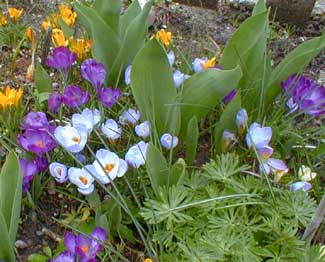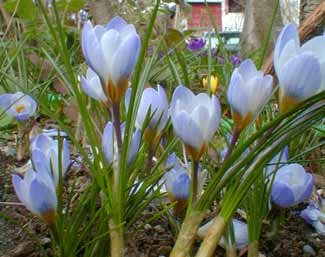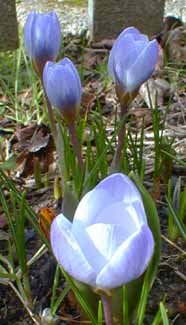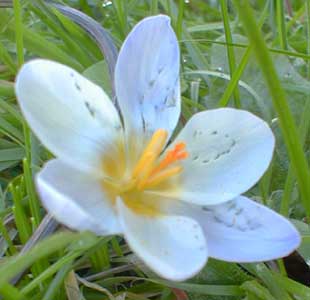 'Blue Pearl'
'Blue Pearl'
Snow Crocus
"Not for a fading summer's morn,
Not for a fleeting hour,
But for an endless age of bliss,
Shall rise our heart's dear flower."
-Harriet Beecher Stowe,
"The Crocus," 1858
"The Crocus," 1858
Introduced by Gerald H. Hageman of The Netherlands in 1950, Crocus chrysanthus 'Blue Pearl' has become one of the standard garden crocuses very widely distributed around the world.
 Occasionally a gardener may be overwhelmed with an inappropriate elitism & want rarer kinds of crocuses that not just anyone can easily obtain. But bear in mind 'Blue Pearl' is a recipient of the Royal Horticultural Society's Award of Garden Merit, & truly a splendid variety.
Occasionally a gardener may be overwhelmed with an inappropriate elitism & want rarer kinds of crocuses that not just anyone can easily obtain. But bear in mind 'Blue Pearl' is a recipient of the Royal Horticultural Society's Award of Garden Merit, & truly a splendid variety.The majority of the crocus varieties in this species naturalize easily, & 'Blue Pearl' does so more easily than most.
 The classic snow crocus species & varieties are often defined as "early" blooming because it gets ahead of spring, this one is so "early" it should really be thought of as "late winter."
The classic snow crocus species & varieties are often defined as "early" blooming because it gets ahead of spring, this one is so "early" it should really be thought of as "late winter."In our garden it begins blooming mid February or slightly earlier & lasts until mid March or a bit longer in an ideal year. In a year less than ideal they can be battered into early submission by heavy rainfall.
The second photograph (at right) was taken mid-Febuary (2003) when the 'Blue Pearl' was well enough along with its budding to be pretty, days before they began opening into flower. The third photo is from late-February (2004). The fourth photo is from early February (2006), a year when most of the crocuses were blooming one to six weeks earlier than most previous years, as we had a warmish winter with a record-breaking number of days of precipitation. Most of the 'Blue Pearls' waited until partway into the second week of February to open fully, but that final snapshot of a lone bloom was even further ahead of schedule.
 It is a stunning shimmering shade of pale blue on the outside, & faded to a creamy pearlescence on the inside, with yellow heart. They are smallish to medium blooms, rounded & sturdy, not easily beaten down if they experience a hard rain.
It is a stunning shimmering shade of pale blue on the outside, & faded to a creamy pearlescence on the inside, with yellow heart. They are smallish to medium blooms, rounded & sturdy, not easily beaten down if they experience a hard rain.Furthermore, they are "bunch flowering" meaning each corm can produce more than one bloom. This renders them particularly floriferous & as few as a dozen bulbs can look like a very sizeable densely flowering drift.
In the March 9 (2003) portrait at the page top you can also see a Crocus x luteus 'Stellaris' which is dark purple & a bright yellow. Near the right hand bottom corner there's also one lingering little C. chrysanthus 'Cream Beauty'. The biggest & darkest purple crocus mixed with these is C. tommasinianus 'Ruby Giant.' The delphinium-like leaves intruding into the bottom corner of the photo actually marks the first hint of the return of a 'Newry Blue' Monkshood which had shown no sign of itself a mere week earlier.
We planted the 'Stellaris' ourselves, but all the other crocuses in the above photo, including 'Blue Pearl,' are naturalized from some long-ago plantings. Digging up that area a great deal while adding shrubs & perennials did not slow these fully naturalized crocuses down one bit.
As with all crocus, 'Blue Pearl' wants full sun, & do not open on overcast or rainy days, but will even so tolerate a bit of shade if they need to. They like dampness in spring & dryness in summer, but are frequently planted in gardens that are well-watered through summer, & 'Blue Pearl' seems to bear up to it. If placed near the root crowns of deciduous shrubs, they'll get the sun they need in late winter & early spring when they bloom, then when they are dormant, the roots of the shrubs will soak up the water to keep the corms from steeping in too much moisture, so not at risk of rot.